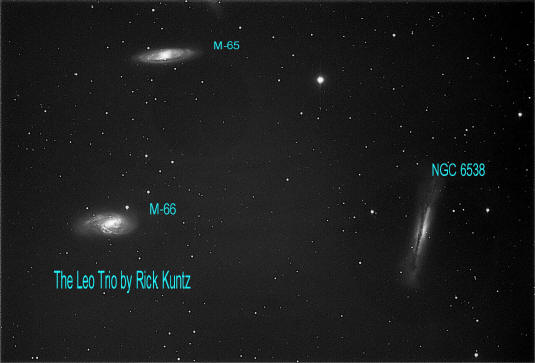|
The Night Sky of May
Dr. Wayne Wooten
Professor of Astronomy
For May 2012 , the moon, just past first quarter and high overhead, passes seven degrees south of Mars on May 1st. The waxing gibbous moon passes about six degrees south of Saturn in
the SE evening sky on May 4th. The rose moon, the Full Moon for May, will be on May 6th. The last quarter moon is on May 24. This new moon produces an annular solar eclipses, but only for the western half of the US
and the Pacific Rim. The sun has already set here on May 20th, and we do not see a solar eclipse locally until the Ďbig oneí, August 21, 2017, which will be 82% covered here, and total about 300 miles north of us in
Tennessee and the Carolinas. At monthís end, the first quarter moon again sits high overhead at sunset, only six degrees south of Mars in Leo.
Mercury lies too close to the Sun for observation this month, and Venus will soon join him. She starts May dominating the western sky, setting about 10:40 PM, a crescent 26% sunlit
with a disk 38" of arc across. But she begins retrograding on May 5th, heading back toward the sun. At monthís end, she is much closer to us and larger, in both the telescope and hand held binoculars, now 57" of arc
across, but a very slender crescent only 1% sunlit. Watch Venus change dramatically in evening twilight with scope or binocs, best seen about 30 minutes after sunset against a blue twilight background. Remember that
on June 5th, starting about 5 PM CDT, we will witness a very rare transit of Venus, when it passes directly between us and the Sun.
Mars is being left behind and fading fast, but still obvious overhead near Regulus in Leo. Its reddish color makes it easy to spot. Jupiter is now lost in the sunís glare, not to
return into the morning sky until late June. Saturn is the brightest object in the southeast as darkness falls; it lies just east of the bright star Spica in Virgo now. Its rings are now opened up to 13 degrees, much
more visible than when they were edge-on during 2010ís Saturnian Equinox. You may also see some belts and zones on the planetís disk. The largest moon, Titan, will be seen in any small telescope, but others will need
larger scopes to spot. As the planet is now only half are bright as when the bright rings are tilted more open, up to six moons may be spotted, in a straight line with the rings, with an eight inch telescope.
The winter constellations will soon be swallowed up in the Sunís glare, but Orion is still visible, with its famed Orion Nebula, M-42, seen below the three stars marking his famed
belt. Dominating the southwest is the Dog Star, Sirius, brightest star of the night sky. When Sirius vanishes into the Sunís glare in two months, this sets the period as "Dog Days".
The brightest star in the NW is Capella, distinctively yellow in color. It is a giant star, almost exactly the same temperature as our Sun, but about 100X more luminous. Just south of
it are the stellar twins, the Gemini, with Castor closer to Capella, and Pollux closer to the Little Dog Star, Procyon.
Overhead, the Big Dipper rides high. Good scouts know to take its leading pointers north to Polaris, the famed Pole Star. For us, it sits 30 degrees (our latitude) high in the north,
while the rotating earth beneath makes all the other celestial bodies spin around it from east to west. If you drop south from the bowl of the Big Dipper, Leo the Lion rides high. Note the Egyptian Sphinx is based on
the shape of this Lion in the sky. Below the triangle that marks the lionís hand quarters you find the "Leo Trio" of galaxies, M-65, M-66, and NGC 6538. They are obviously distorted and interacting in photo this
month.

Taking the arc in the Dipperís handle, we "arc" SE to bright orange Arcturus, the brightest star of spring. Cooler than our yellow Sun, and much poorer in heavy elements, some believe
its strange motion reveals it to be an invading star from another smaller galaxy, now colliding with the Milky Way in Sagittarius in the summer sky. Moving almost perpendicular to the plane of our Milky Way, Arcturus
was the first star in the sky where its proper motion across the historic sky was noted, by Edmund Halley. Just east of Arcturus is Corona Borealis, the "northern crown", a shapley Coronet that Miss America would
gladly don, and one of few constellations that look like their name. The bright star in the crownís center is Gemma, the Gem Star.
Spike south to Spica, the hot blue star in Virgo, then curve to Corvus the Crow, a four sided grouping. As noted earlier, Saturn is the only planet now in the evening sky, and is
located to east of Spica, and more yellow in color and slightly brighter than Spica as well. Our large scopes will show members of the Virgo Supercluster, a swarm of over a thousand galaxies about 50 million light
years away from us.
Read past issues of the Sky at Night
|